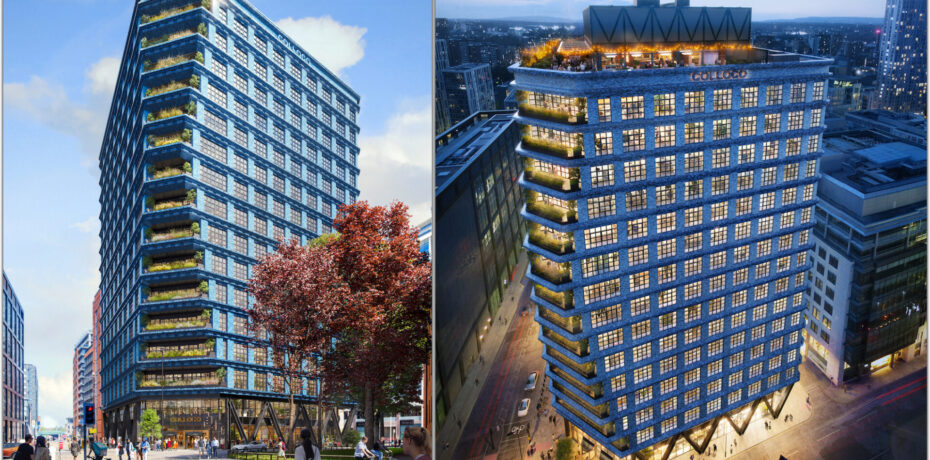The Subplot
The Subplot | Manchester offices, A1 dualling, fancy thinking
Welcome to The Subplot, your regular slice of commentary on the business and property market from across the North of England and North Wales.
THIS WEEK
- Lucky numbers: why vacancy rates aren’t the most important numbers in Manchester’s office market
- Elevator pitch: your weekly rundown of who and what is going up, and who is heading the other way
LUCKY NUMBERS
Exactly how vacant?
According to vacancy rate statistics Manchester is facing a Grade A office famine. Is the vacancy rate a number to take seriously, or just another – and not the most important – straw in the wind?
On the face of it, Manchester has a grave shortage of good, modern, and available new office floorspace – Grade A, the product that sends occupiers wild with desire. Knight Frank calculated Manchester’s Grade A vacancy rate at 5.2% at the end of Q2 2023, down from 10% at the start of the year. That’s quite a drop. Savills, doing the sums a bit differently, agreed it’s falling but put the current position at around 3%.
Get moving
Developers should get their skates on, hints Manchester City Council. “There is currently a shortage of new office space, highlighted by the fact that office vacancy rates have reduced to around 3%. Additional new, quality office space is, therefore, needed for Manchester to remain competitive,” says a report presented to the ruling executive yesterday.
You’re gonna love it
Developers are aware. This week HBD launched plans for 200,000 sq ft of “future-facing workspace” at Colloco, on the Spinningfields-St John’s border, Place North West reported. This £140m proposal appeared as MEPC wrapped up building work on the 200,000 sq ft 4 Angel Square in the NOMA district. Both will come with the full panoply of accreditation, not least a high NABERS rating for operational energy efficiency.
Normal for Manchester
But wise heads aren’t getting carried away. As the Savills data shows, the Manchester Grade A office vacancy rate is always small. The impression that it is both unusually small and shrinking only arises because 2020 was a bumper year (5%) and it’s been falling back to the more-or-less usual level ever since.
Beware comparisons
Context matters, too. Comparisons between cities are dangerous. So, for instance, is a 5.5% office vacancy rate a bad thing? According to the Cluttons-CoStar data, that was the overall Leeds vacancy rate in Q1 2023. In Leeds this is a shade above, but not massively out of line with, the five-year average – so all is well. But in Manchester a 5.5% vacancy rate would be a miracle – seriously eye-popping, indicating something was going on – because the five-year average is close to 7%, as it is in Birmingham and Central London.
Doing this the other way ’round, if Leeds had a vacancy rate of 7% that would count as a cataclysm, and we’d probably be into the End Times if it reached Manchester’s Q1 figure of 8.5%. To repeat: other data sets are available, but you get the idea. The uncontextualised vacancy rate is, on its own, not much use.
Don’t tell anyone
So here’s a secret: chatter about vacancy rates is what the Manchester office market does when it’s no longer fun to talk about take-up. This is what’s now happening after a miserable first half of 2023 featuring a slump in deal volumes which began to look awkward as summer began.
Even so
JLL’s James Devany chuckles good-naturedly at the suggestion that vacancy rates are a distraction from the ugly facts. “Yes, it hasn’t been a good H1 for Manchester. It’s been tough,” he says.
But he insists that as M&G’s Lincoln Building lets, 4 Angel Square follows, and St Michael’s fills up, the pressure to build will grow. “We’ve only got 3 Circle Square completing in late 2025 [267,000 sq ft] so whilst the take-up figures are debatable and subjective, the fact is developers will increasingly see a gap in the market.”
Time for a think
A crisis? “[The Grade A vacancy rate is] no crisis and this is not an unusual state of affairs at this point in the cycle,” says Knight Frank office guru and Manchester boss David Porter. Occupiers want smart new buildings, but developers have trouble providing them, he explains. Occupiers need to think about pre-lets, Porter says, if they want new floorspace because they change the tricky high-risk maths of building Grade A office space: they turn a gamble into a sure thing.
It’s tricky maths
Without pre-lets, the build-or-not-to-build calculation is still finely balanced. Although construction inflation is easing, a little, it’s still uncomfortable: tender prices grew by almost 5% in Q2 2023 compared to Q2 2022, so the Building Cost Information Service says. Tender price inflation is growing more slowly in the North West and Yorkshire but is still above the UK average and expected to stay that way for the next couple of years, according to RLB.
Prices, lending
If you want to talk numbers, says Porter, talk about the tender prices and interest rates that figure in developers’ viability assessments. “The viability to build new space or refurbish significant buildings speculatively is still hard to make work, even with rising rents, mainly due to build costs and the price of debt finance,” Porter says. “This is unlikely to change in the immediate future, which will put pressure on the existing stock being upgraded. Occupiers may have to compromise their demands due to this forthcoming lack of supply.”
Learn more about the future of offices on 11 October. Book your Offices + Workspace ticket.
ELEVATOR PITCH
Going up, or going down? This week’s movers
Time for some heretical thinking on economic growth, but well past time to dual the A1 in Northumberland. Doors closing, going up.
Fancy thinking
A new economic strategy is being brewed by Manchester City Council. The plan is in its early stages, and there’s lots of mulling and talking to do first, but some of the research is already pointing in interesting directions. One workstream – the Resolution Foundation’s Economy 2030 Inquiry – proposes a number of heretical ideas about growth which, if followed through, will make a serious difference not just to Manchester, but to a host of mid-sized and small towns with wonky economic notions.
Key findings suggest that growing your everyday economy – shops and local services – has little to offer as a route to prosperity; that there’s not enough highly skilled manufacturing to grow into anything much, and that picking winning business sectors and focusing on them doesn’t work because all sectors suffer pretty much the same fairly generalised problems.
“Rather than predicting future sectors, think about creating conditions for any high value-added activities/tasks,” is how a report to councillors sums it up. The solutions include a much bigger Manchester city centre and lowering constraints on the supply of land. If thinking proceeds along these lines, the new strategy could be fun.
A1 dualling
It’s been a long two years since the Planning Inspectorate completed its examination of proposals to dual the A1 from Morpeth to Ellingham. A decision was due on 5 September but, to much dismay but no surprise, has been postponed again, for the fourth time. A decision is now due by June 2024.
The £290m-plus project involves upgrading less than eight miles of the A1 to a dual carriageway between Morpeth and Felton, including construction of a new dual carriageway bypassing the existing A1 between Priests Bridge and Burgham Park.
Ministers seem to have trouble focusing on this, perhaps because nobody lasts in the department long enough to focus on anything. There have been three transport secretaries in the past 12 months: Grant Shapps, Anne-Marie Trevelyan, and Mark Harper. The stated reason for the delay is to allow more time to think about environmental issues, an explanation the ministry has used before.
Get in touch with David Thame: david.thame@placenorth.co.uk





“Developers should get their skates on, hints Manchester City Council. ” – interesting then their development of significant office space on Central Retail Park seems to be moving at a glacial pace.
By JJ
But hardly anybody is working in offices now, there were three in my office yesterday out of fifty desks, why would companies want to renew unless given a discount?
By Gilly
Dear Gilly
Do staff not need a place to train and interact socially every now and again, so you can… get to know your colleagues slightly?
Do you work for a company which requires complex/expensive/large computers/operating systems that aren’t portable and need to be used by multiple members of staff?
There’s a lot more reasons, but if you work for a company that doesn’t ‘need’ an office, a large majority probably will for the reasons above.
A lot of businesses thought they wouldn’t need offices and at the start of covid, all the trolls thought that Manchester would turn into a ghost town, yet city centre has never been busier.
It’s almost like people do actually love being here.
There’s also the fact that some people don’t have the facilities or environment to work from home.
It would be selfish for a company to expect that of everyone, especially if individuals are having a stressful time and actually need to come to the office so they can earn their money, if it suits them better.
By Try thinking before posting
Hardly anyone working in office? …you want to come to mine…full most days now. WFH now and again works fine for a bit of flexibility but even the Google’s and Apple’s of this world have realised the long term folly.
By Anonymous
Not been in office more than two days/week since covid arrived. Before then it was 5 days/ week. Never again. The genie’s out of the bottle , and it ain’t going back.
By Anonymous
People get told when they are going back, it’s not a choice. There is no Genie, life isn’t magic, that’s how life actually works. Been around the whole work/life balance thing 30 years ago…there is nothing new about this, if someone invests in offices they get to tell you what to do if you don’t like it , you get to move on. This is expensive real estate not the dreams of the Student union.
By Anonymous
No mention of yields. Institutions have been gradually pulling out of the Office market, spooked by the consequences of changing occupational habits. Yields have weakened considerably and with no sign of Institutions having any interest in returning to the office market, what we are left with is debt based buyers – and with debt now costing over 8%, there is no chance of making new schemes viable with the type of yields investors are looking for.
By Anonymous